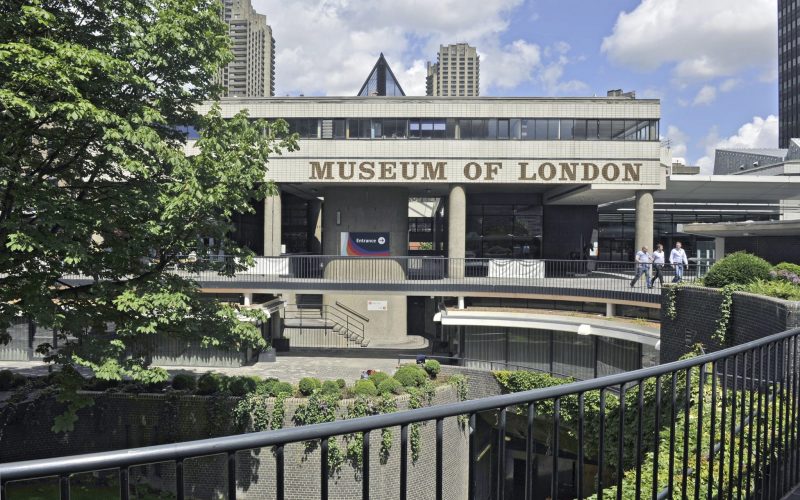
London’s only museum dedicated solely to itself, the Museum of London was born in 1965 out of the Museum of London Act. When it opened in 1976, it featured the combined collections of the City of London at London Guildhall and the London Museum at Kensington Palace. Its exhibits are dedicated to the city’s history and are separated into various eras from prehistoric London (London Before London) to the modern-day (World City). From the death masks of famous Londoners to London symbols of hope, the Museum of London is home to some great artifacts, and we’ve identified ten we think you should see below. Let us know your favorites in the comments.
Roman London
The Roman London part of the museum features a great number of artifacts from the Roman occupation that spanned from roughly 50 AD to 410 AD. As the capital of Roman Britain, London certainly has produced more than its share of stunning museum exhibits. These include pieces pulled from excavations such as coins to the Bucklersbury tiled floor mosaic that was discovered in 1869.
Beckett Pilgrimage Badges
Following the death of Thomas Becket in 1170, his body was interred in the crypt at Canterbury Cathedral. Canterbury then became a major destination for Christian pilgrims (as depicted by The Canterbury Tales), many of whom would buy souvenirs of their journey. These often took the form of badges that depicted Becket’s life. The museum’s exhibits includes not only many of the badges but also facts about Becket’s time in London and his legacy.
Bronze Age Hoard
In a city such as London that’s always building something, these construction projects tend to uncover a lot of archaeological treasures. A huge find of Bronze Age artifacts from Havering, including knives, sword fragments, daggers, ax handles, and more. These items are helping archaeologists to solve the mystery of how people during this era lived.
Fire of London Experience
One of the biggest catastrophes in the city’s history, the Great Fire of London burned 90% of the City of London (not to be confused with Greater London). The museum has a number of exhibits dedicated to the Fire, such as period firefighters’ equipment and items belonging to Samuel Pepys, whose first-person account of the Fire was recorded in his journal. You should also check out the Fire! Fire! Multimedia exhibit that features the conspiracy theories of the Fire’s origin and a recreation of the city in Minecraft as it was in 1666.
Lord Mayor of London’s State Coach
While Greater London has the mayor most people know, the City of London has its own mayor, whose annual procession is part of their inauguration complete with a stately coach. The museum is home to the State Coach when it is not in use for the Lord Mayor’s Show. The coach has been in use since 1757 and is gorgeous with its gilded features and rococo design.
Pleasure Garden Recreation
The pleasure gardens of the 18th Century are dutifully recreated at the Museum of London, including many of the features that marked these places of respite in a bustling and dirty city. The gardens feature real trees and mannequins dressed in period costume as Georgian Londoners would have used these places as an excuse to show off their best clothes.
Selfridges Lift
One of the best examples of art deco in the city, the Selfridges Lift, was originally in the department store in 1928 and was immaculately decorated in the style of the time. The exterior features metalwork depicting Zodiac figures while the inside has gorgeous bronze panels. The lift serves as a perfect example of how glamorous the shopping experience was and became part of the museum’s collection after a 1972 refurbishment.
Oliver Cromwell Death Mask
Arguably one of Britain’s most notorious figures, Oliver Cromwell served as Lord Protector of the United Kingdom following the English Civil War and execution of King Charles I. His Protectorate did not last long after his death in 1658 and the mask on display shows him as he was, literal warts and all.
Victorian Walk
Another of the museum’s recreations, the Victorian Walk takes visitors down a typical late-19th Century street. Shop windows show off the fashions and popular goods of the period along with the signs that advertised them.
2012 Olympic Cauldron
While most of us watched the 2012 Olympics on television, the Olympic Cauldron that once stood in London Stadium. The cauldron was designed by Thomas Heatherwick and comprised of 204 separate “petals” to represent the individual countries participating in the games. A grouping of the petals and mechanism that operated them as been part of the museum since 2014.
Ten Things to See at the Museum of London — Londontopia — The Website for People Who Love London
Source: Londontopia

Комментариев нет:
Отправить комментарий